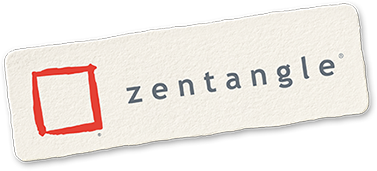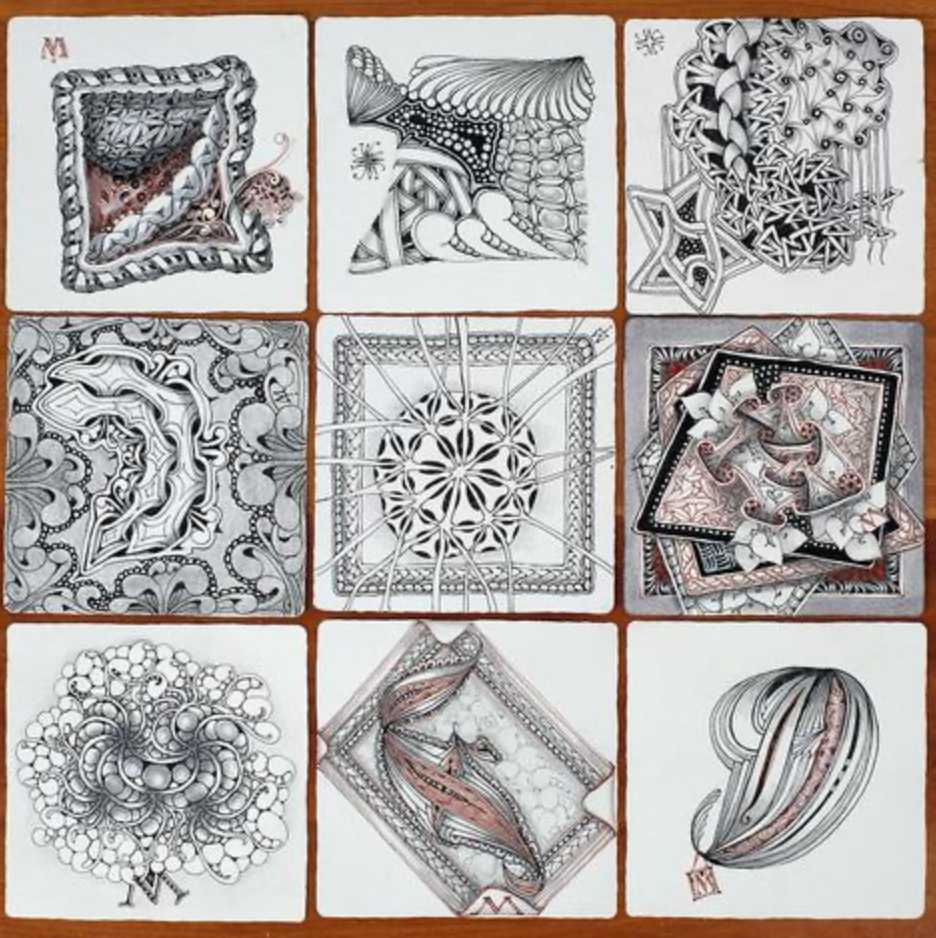In 2007, we started BLOG Zentangle and began our enjoyable series of conversations within our Zentangle community.
In reading through these blog posts with their insightful comments, we decided to bring a few of them to your attention from time to time. It is easy, for me anyway, to sometimes think of old information as stale information. But these insights and conversations are anything BUT stale!
We invite you to enjoy this post from 2018...
Rick writes:
I want your advice.
This post contains math. I think it’s right, but I’m not sure.
To all you math wizards (or friends of math wizards), please tell me how I did.
It’s a good story even without the math. I’d love to read your thoughts.
Thank you!
About a year after our Zentangle adventure began, a friend and CEO of a regional corporation invited Maria and me to give a Zentangle workshop at his company’s annual meeting for executives and managers.
We gave our workshop after their lunch and before their meeting. About 40 people were there.
The tables were arranged in a horse-shoe fashion with people sitting on the outside. We stood at the open end with a large screen behind us to project what we would draw.
We handed out paper tiles, pens and pencils and introduced the Zentangle Method. As we guided people through the process, each person became immersed in their drawing. There was pin-drop silence in the room.
When we finished, every tile was unique even though you could see how each had followed the same guidance. Each person interpreted what we said through the lens of their individual expression.
Everyone placed their finished tiles on a card table in the middle of the horseshoe. Each tile was unique even though you could see how each had followed the same guidance. Each person interpreted what we said through the lens of their individual expression.
Together, the tiles formed a “mosaic” (which is why we call them “tiles”). As people added their tiles to the mosaic, you could hear their appreciation for other’s tiles and their often surprised appreciation for their own tiles as they viewed them in this larger context.
Coffee was served and people sat back down. We gathered our gear, said our goodbyes and they proceeded with their meeting.
We later learned that this annual meeting was the most productive and shortest in the company’s history. I like to think it was because of the card table holding their creations remained in front of everyone. The CEO’s tile was not distinguishable from the tile of the most recent hire. The mosaic that faced them was unique and could only exist because of each person’s unique tile.
After that workshop, I began thinking about a tile in a mosaic as a metaphor for an individual in a group. And I began thinking about the mosaic as a metaphor for a group.
Rearrange and rotate the tiles in different ways and you get a different mosaic.
To extend my metaphor, I wondered how many groups there might be if the same people sat in different seats with one of four different moods. So I made up a thought experiment for a group of 36 people.
Here it is.
Pretend each person has only two possible states:
- Tired or Rested and
- Hungry or Full
That means each person is either:
- Rested and Full, or
- Rested and Hungry, or
- Tired and Full, or
- Tired and Hungry
These options represent the four ways you can position a square tile in a mosaic.
Let’s also pretend there are six rows of six seats where the group sits.
The question for this thought experiment is:
“How many permutations can there be for a group of 36 people with two binary variables who can sit anywhere in six rows of six seats?”
Last week I decided to figure it out. When I did, I couldn’t believe the numbers! I’ll show you them at the end, but first let’s start with a smaller mosaic, one with only four square tiles. Before you scroll further, take a guess how many ways you can arrange this mosaic.

At first, I tried figure it by drawing pictures, but I soon realized that could take hours. So I searched online and ended up with this formulas for permutations of a certain number of tiles (or people) and a certain number of variables for each tile (or person):
(r^n x n!) / r
r = the number of possible rotations of a tile (3 for a 3Z and 4 for a square tile)
n = the number of tiles in the mosaic
(! represents the factorial of the number it follows. So 5! would be 5 x 4 x 3 x 2 x 1 = 120. I had to (re)learn that for this exercise.)
OK, let’s play with the four-tile mosaic.
(4^4 x 4!) / 4 = (256 x 24) / 4 = 6,144/4 = 1,536
There are 1,536 different ways you can arrange four tiles in a two by two mosaic!
Actually there are 6,144 ways you can arrange the mosaic from the perspective of any one side, but I decided to be conservative and assume that you can walk around the mosaic and view it from any side.
How many permutations do you think this three by three mosaic of nine tiles has?

Let’s do the math:
(4^9 x 9!) / 4 = (262,144 x 362,880) / 4 = 95,126,814,720/4 = 23,781,703,680
Yes, that’s over 23 billion (with a B) permutations!
Before we get to that meeting mosaic, let’s doing one more, a mosaic of 16 3Z tiles. Care to guess how many permutations of this mosaic?

Here we go . . .
(3^16 x 16!) / 3 =
(43,046,721 x 20,922,789,888,000) / 3 =
9.006574988504e20 / 3 = 3.002191662835e20 which looks like
300,219,166,283,500,000,000
Or, just “slightly” over 300 quintillion which is one billion times one billion times 300!
Okay, let’s solve my original question.
Ready?
Any guesses? (LOL)
Here we go:
(4^36 x 36!) / 4 =
(4.72236648287e21 x 3.719933267899e41) / 4 =
1.756688818284e63 / 4 =
4.39172204571e62 or in other numbers:
439,172,204,571,000,000,000,000,000,000,000,000,000,000,000,000,000,000,000,000,000
or, a billion times a billion times a billion times a billion times a billion times a billion times 439,172,204.570951
Seriously?
Well, as I edited this I realized that if we’re talking about tiles which don’t change, but you can orient in four ways then, yes. But if we’re talking about individuals that can present themselves in four different combinations of tired/hungry, etc., then it’s that number times four.
A Zentangle mosaic is inspiring BECAUSE each tile is unique. What would be the fascination of a mosaic when each tile is the same as every other one?
What stunned me about this exercise is how MANY permutations exist for a mosaic of just a few tiles.
And when you appreciate how many more variables any individual has than the three or four variables of a tile . . . well . . .
The next time someone suggests you can presume an identity of a group based on the individuals, or the orientation of a single person because of their group, just get out 9 square tiles and your calculator and have some fun!
==
NOTE:
Another way you can approach this is to imagine four tiles and an empty 2 by 2 grid.
When you pick up the first tile you have four places in the mosaic you can place it and there are four rotations, in 90 degree increments to choose from. In other words, there are 16(4 x 4) ways to put that tile in the mosaic.
When you are ready to place the second tile in the mosaic, there are only three spaces left but you still have four ways you can orient that tile so you have 12 (3 x 4) ways to position that second tile.
With two remaining spaces for the third tile there are 8 options (2 x 4) and the last tile goes in the remaining space in one of four ways (1 x 4).
You will notice that we get the same result this way:
16 x 12 x 8 x 4 = 6,144
. . . which I divided by four for reasons stated above.



Can you explain that again!?! 🤪
Carol M on
I am a math atheist (thanks for the phrase, Calvin and Hobbs cartoon!) but found this number play fascinating! A single tile can be seen four different ways on its own. Add even just one other tile next to it and the first tile decides to pair with the second to create a new way to look at both tiles separately and together. We can rearrange our tiles hourly to give us another stimulating view of our artwork.
Thank you for our math lesson, Rick. I think it is time for chocolate milk, shortbread cookies, and some tangling tools!
onna on
My head just exploded.
Kathy Y. on